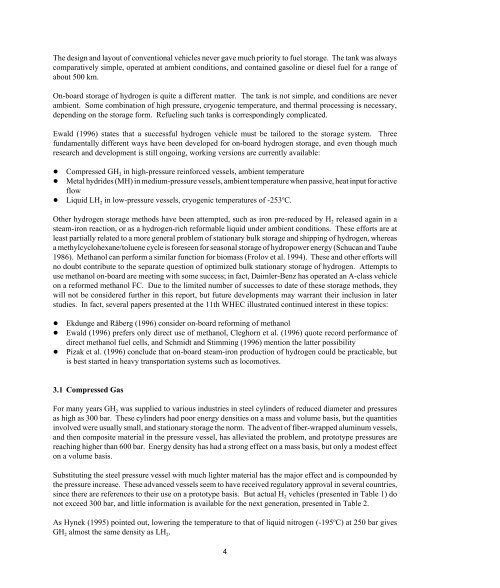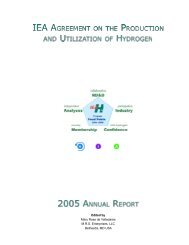Technology Status of Hydrogen Road Vehicles
Technology Status of Hydrogen Road Vehicles
Technology Status of Hydrogen Road Vehicles
You also want an ePaper? Increase the reach of your titles
YUMPU automatically turns print PDFs into web optimized ePapers that Google loves.
The design and layout <strong>of</strong> conventional vehicles never gave much priority to fuel storage. The tank was always<br />
comparatively simple, operated at ambient conditions, and contained gasoline or diesel fuel for a range <strong>of</strong><br />
about 500 km.<br />
On-board storage <strong>of</strong> hydrogen is quite a different matter. The tank is not simple, and conditions are never<br />
ambient. Some combination <strong>of</strong> high pressure, cryogenic temperature, and thermal processing is necessary,<br />
depending on the storage form. Refueling such tanks is correspondingly complicated.<br />
Ewald (1996) states that a successful hydrogen vehicle must be tailored to the storage system. Three<br />
fundamentally different ways have been developed for on-board hydrogen storage, and even though much<br />
research and development is still ongoing, working versions are currently available:<br />
! Compressed GH 2 in high-pressure reinforced vessels, ambient temperature<br />
! Metal hydrides (MH) in medium-pressure vessels, ambient temperature when passive, heat input for active<br />
flow<br />
! Liquid LH 2 in low-pressure vessels, cryogenic temperatures <strong>of</strong> -253 o C.<br />
Other hydrogen storage methods have been attempted, such as iron pre-reduced by H 2 released again in a<br />
steam-iron reaction, or as a hydrogen-rich reformable liquid under ambient conditions. These efforts are at<br />
least partially related to a more general problem <strong>of</strong> stationary bulk storage and shipping <strong>of</strong> hydrogen, whereas<br />
a methylcyclohexane/toluene cycle is foreseen for seasonal storage <strong>of</strong> hydropower energy (Schucan and Taube<br />
1986). Methanol can perform a similar function for biomass (Frolov et al. 1994). These and other efforts will<br />
no doubt contribute to the separate question <strong>of</strong> optimized bulk stationary storage <strong>of</strong> hydrogen. Attempts to<br />
use methanol on-board are meeting with some success; in fact, Daimler-Benz has operated an A-class vehicle<br />
on a reformed methanol FC. Due to the limited number <strong>of</strong> successes to date <strong>of</strong> these storage methods, they<br />
will not be considered further in this report, but future developments may warrant their inclusion in later<br />
studies. In fact, several papers presented at the 11th WHEC illustrated continued interest in these topics:<br />
! Ekdunge and Råberg (1996) consider on-board reforming <strong>of</strong> methanol<br />
! Ewald (1996) prefers only direct use <strong>of</strong> methanol, Cleghorn et al. (1996) quote record performance <strong>of</strong><br />
direct methanol fuel cells, and Schmidt and Stimming (1996) mention the latter possibility<br />
! Pizak et al. (1996) conclude that on-board steam-iron production <strong>of</strong> hydrogen could be practicable, but<br />
is best started in heavy transportation systems such as locomotives.<br />
3.1 Compressed Gas<br />
For many years GH 2 was supplied to various industries in steel cylinders <strong>of</strong> reduced diameter and pressures<br />
as high as 300 bar. These cylinders had poor energy densities on a mass and volume basis, but the quantities<br />
involved were usually small, and stationary storage the norm. The advent <strong>of</strong> fiber-wrapped aluminum vessels,<br />
and then composite material in the pressure vessel, has alleviated the problem, and prototype pressures are<br />
reaching higher than 600 bar. Energy density has had a strong effect on a mass basis, but only a modest effect<br />
on a volume basis.<br />
Substituting the steel pressure vessel with much lighter material has the major effect and is compounded by<br />
the pressure increase. These advanced vessels seem to have received regulatory approval in several countries,<br />
since there are references to their use on a prototype basis. But actual H 2 vehicles (presented in Table 1) do<br />
not exceed 300 bar, and little information is available for the next generation, presented in Table 2.<br />
As Hynek (1995) pointed out, lowering the temperature to that <strong>of</strong> liquid nitrogen (-195 o C) at 250 bar gives<br />
GH 2 almost the same density as LH 2.<br />
4













